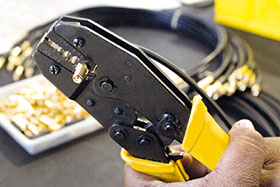

A key part of any purchaser’s job is to ensure that their place of employment remains competitive at all times, which leads to negotiation with suppliers in order to drive down purchase prices. It is not uncommon for companies to be attracted to the relatively low cost of imported, complete cable assemblies because, on the face of it, this always presents itself as an area where cost savings can be achieved. Add to this the relatively high cost of RF cable assemblies and, if managed correctly, it would seem that massive cost savings can be achieved. But does this perception hold true during times of a weakening Rand, or indeed at all?

The answer to this conundrum is more complicated than merely a quick, cursory glance at a Dollar price multiplied by an exchange rate. Firstly, one thing which catches out many less experienced companies is the import duty of 15% applicable to imported RF cable assemblies. So all of the input costs to the completed assembly, being the raw materials (RF connectors, heatshrink and cable), plus the labour content are all effectively increased by this duty. Secondly there is the added freight. Unless one has the luxury of catering for a 12 week component lead-time, air freight is usually selected, and this adds significant cost to cable assemblies, easily a further 20-30% onto the cost price.
All of the above costs are of course 100% linked to the exchange rate, meaning that during a period of a weakening Rand, as we experienced over August/September this year, the landed cost of any imported products begins to spiral upwards very quickly.
As a comparison, the input costs for locally manufactured assemblies carry some stark differences. Firstly, the duty on the imported connectors is 5%, not 15% as is the case for a complete, imported assembly. The physical RF cable itself still carries a 15% duty, and the goods themselves still have to be transported to South Africa, but this is normally done in bulk, via sea freight, which yields a far lower landed cost price for the materials versus air freight. The labour content for the completed assembly is a local Rand input cost, unaffected by the exchange rate.
The complexity of the input costs can be summarised as follows: particularly when the Rand is weak, local pricing and relatively fast turnaround time are both hugely attractive to customers. This is why we continue to support the local market with locally manufactured cables. Not only do we feel strongly about preserving and growing local jobs, but when managed correctly, local manufacture can be a highly attractive source of supply for local companies.
Our operators are trained to IPC/WHMA-A-620, which is an international standard, ensuring that the quality of the work remains of a high standard regardless of the choice of connector (SMA, BNC, N-TPE, MCX, MMCX, SMA and U-FL being the common choices).
We make use of semi-automated coaxial strippers, which ensures that consistency is maintained across multiple batches of assemblies, irrespective of whether a client has elected to use RG58, RG174, RG316, LMR195, LMR200, LMR400 or even 1,13 mm coaxial cable.
In addition, as an ISO9001:2015 company, all our test and manufacturing equipment is calibrated regularly, ensuring that when customers require test certificates, these are provided with confidence in the accuracy of the information being presented.
| Tel: | +27 11 791 1033 |
| Email: | wireless@otto.co.za |
| www: | www.otto.co.za |
| Articles: | More information and articles about Otto Wireless Solutions |

© Technews Publishing (Pty) Ltd | All Rights Reserved